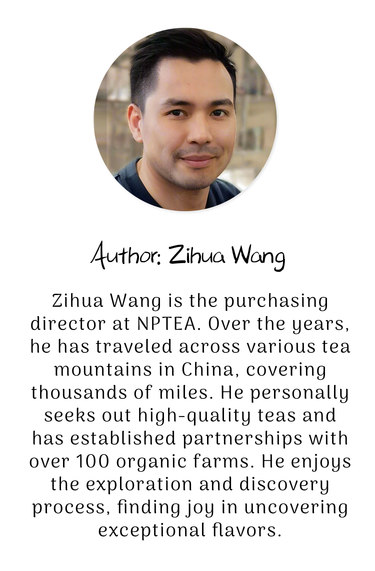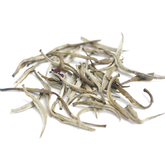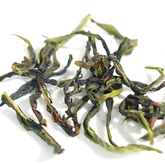A Complete Guide to Lapsang Souchong: Origins, Taste, Brewing Tips, and Health Benefits
Lapsang Souchong is a distinctive black tea from the Wuyi Mountains in Fujian, China. It is one of the oldest black teas in the world, known for its unique pine-smoked aroma. Unlike typical broken-leaf black teas, Lapsang Souchong is a whole leaf tea, and in fact, the majority of Chinese teas are loose leaf.
The dry tea leaves of Lapsang Souchong are twisted, dark, and shiny with golden tips. When brewed, the tea has a bright red color, with subtle fruity and honey-like fragrances. Some traditional Lapsang Souchong teas even carry a mild woody smoky aroma. As a sourcing manager with years of experience in the Chinese tea industry, this article will offer a comprehensive analysis of this classic black tea, covering its origin, processing, flavor, brewing, and tips for selecting quality tea.
Recommended purchase:
Black Tea—Lapsang Souchong Black Tea (Zheng Shan Xiao Zhong)

Where is Lapsang Souchong from?
Lapsang Souchong originates from the Tongmu Guan area near the Wuyi Mountains National Nature Reserve in Fujian Province, China. This is a remote village with high average elevation and an ideal ecological environment that provides excellent conditions for tea cultivation. This is one of the core reasons behind the unique flavor profile of Lapsang Souchong.

Tongmu Guan is the most authentic and core production area for Lapsang Souchong, and the black tea produced here is the most famous—and also the most expensive. The term "Zhengshan" (meaning "authentic mountain") refers to the high-quality tea from this core area. Tea produced in other regions of Wuyi Mountain is often referred to as "Waishan Xiaozhong" (outer mountain Lapsang Souchong), and its quality and flavor differ from those produced in the core Tongmu Guan area.
The importance of the origin is crucial. The unique geographical and climatic conditions of Tongmu Guan, combined with traditional processing methods, make Lapsang Souchong stand out from ordinary black teas. Other areas in Fujian also produce black tea, sometimes labeled as Lapsang Souchong, but their flavor will not match the true essence of Tongmu Guan.
The History of Lapsang Souchong
Lapsang Souchong was first developed in the mid-17th century in the Wuyi Mountains, making it the world's first black tea. The techniques used in other famous Chinese black teas , such as Keemun and Dianhong , trace their origins back to Lapsang Souchong. Later, internationally popular teas like Darjeeling, Assam, and Ceylon also borrowed from the traditional Lapsang Souchong production methods.

The most widely circulated origin story of Lapsang Souchong involves a beautiful "accident" during a time of war. In the Ming Dynasty, during the Longqing period (1568), tea farmers in Tongmu Guan, Wuyi Mountains, were caught off guard by an army passing through. The freshly picked green tea leaves were left unattended and unexpectedly fermented into red tea.
In an attempt to salvage the situation, the tea farmers smoked the leaves over local pinewood, which led to the creation of a tea with a unique smoky and sweet lychee flavor—Lapsang Souchong, the world's first black tea.
Due to its distinctive smoky flavor and rich taste, Lapsang Souchong became wildly popular in Europe, especially among the British elite. It was initially called "Bohea" (a transliteration of Wuyi) or Lapsang Souchong, making it one of the first Chinese black teas to reach European markets.
How is Lapsang Souchong Made?
As one of the oldest black teas in the world, Lapsang Souchong uses a fully fermented process. The production method is meticulous and includes the following key steps:
Picking: Only the tender, fresh leaves from the small-leaf tea trees of the Wuyi Mountains are used (usually one bud and two leaves).
Withering: The leaves are allowed to lose moisture naturally or are heated at low temperatures to soften them, making the subsequent rolling process easier.
Rolling: The leaves are twisted to break their cells, releasing juice and shaping them into twisted strips.
Fermentation: The critical process for black tea, where the tea leaves oxidize, turning them red and creating the characteristic sweet, mellow taste and reddish liquor.
Drying: This step fixes the tea's aroma and results in the finished dry tea leaves.
In traditional Lapsang Souchong production, the final step involves slow drying over pinewood charcoal, imparting a mild smoky flavor to the tea. This was a key characteristic when the tea was first exported to the European market and is often considered the signature process of Lapsang Souchong.
It’s important to note that, in modern times, especially for the Western market, consumers are less tolerant of heavy smoky flavors. Therefore, most Lapsang Souchong teas available today either reduce or completely eliminate the pinewood smoking process to cater to broader taste preferences.
What Does Lapsang Souchong Taste Like?
For Western tea drinkers, the flavor of Lapsang Souchong often brings an element of surprise, as it differs dramatically from the typical English breakfast tea or regular bagged black tea. This traditional Chinese black tea offers a more natural, gentle, and multi-layered tasting experience. The flavor profile of Lapsang Souchong depends significantly on the production method used.
For traditionally crafted Lapsang Souchong, the taste is characterized by a mild woody smoky aroma, reminiscent of the scent of burning wood in a fireplace, or even smokey cheese or roasted nuts. This smoky taste is not overwhelming; instead, it complements the smooth, mellow flavor of the tea itself.
Modern Lapsang Souchong emphasizes natural fruity and honey-like aromas, removing the smoky element. Its flavor is smoother, sweeter, and more refined, with hints of ripe blackberries, honey, or maple syrup. The mouthfeel is smooth and sweet, with a clean finish that leaves a light fruitiness and natural sweetness in the aftertaste.
How to Brew Lapsang Souchong?
Easy Brewing Method : A mug or glass cup is ideal for quick, everyday enjoyment of Lapsang Souchong.

Water Temperature: 90-95°C, avoid boiling water to prevent bitterness.
Tea-to-Water Ratio: 3-5g of tea per 300ml of water
Steeping Time: 2-3 minutes
Traditional Gongfu Brewing : For those seeking a more refined experience and a layered taste, a Gaiwan (Chinese lidded bowl) is perfect for brewing.

Tea-to-Water Ratio: 5g of tea per 120ml of Gaiwan.
Water Temperature: 90-95°C, avoid boiling water to prevent bitterness.
Brewing Method: Pour out the tea after 5-10 seconds; do not let it steep too long.
High-quality Lapsang Souchong can be steeped 6-8 times.
How to Store Lapsang Souchong?
As a fully fermented black tea, Lapsang Souchong does not "expire" in the strict sense, but over time, the tea’s aroma and flavor will diminish due to continued oxidation. Proper storage is essential to preserve its flavor.

Here are the key points for storing your tea:
Sealed: Store in airtight containers or tea bags to prevent exposure to air.
Avoid Light: Place it in a cool, dry location, away from direct sunlight to prevent spoilage.
Humidity Protection: Keep it away from humid environments to avoid moisture that could alter its flavor.
No need to refrigerate; normal room temperature storage is sufficient. Under proper conditions, Lapsang Souchongmaintains its best flavor for 1-2 years.
Is Lapsang Souchong Healthy?
As a fully fermented black tea, Lapsang Souchong, like other black teas, contains abundant bioactive compounds, and moderate consumption can offer several potential health benefits. These benefits stem from the conversion of polyphenols during fermentation, as well as other natural ingredients.
From a scientific perspective, moderate consumption of Lapsang Souchong can provide health benefits. The tea’s theaflavins, thearubigins, and natural polyphenols have antioxidant properties, helping to delay cell aging and support daily antioxidant maintenance (Cabrera et al., 2006). Additionally, black tea’s gentle nature makes it easier on the stomach, helping with digestion and alleviating greasy or heavy meals. Studies have also shown that tea polyphenols may help regulate blood lipids and support cardiovascular health (Gardner et al., 2007).
While Lapsang Souchong is not a medicinal drink, pregnant women, children, and those sensitive to caffeine should consume it in moderation. As a daily health beverage, drinking Lapsang Souchong in moderation can support metabolism and offer antioxidant benefits, all while enjoying its flavorful experience.
How to Select Quality Lapsang Souchong?
When purchasing Lapsang Souchong, the first thing to check is the production date and expiration date. Although black tea doesn’t technically “expire”, fresh tea offers the best flavor, so avoid buying near the expiration date, as older tea loses its fragrance and flavor.
Next, not all teas labeled “Lapsang Souchong” are from the core Tongmu Guan production area. Tea from this core area tends to have better fragrance and aftertaste, so focus on product labels that highlight the origin and brand certification.

Finally, avoid buying flavored or artificially scented Lapsang Souchong. Quality Lapsang Souchong should have whole leaves, not broken tea or dust. For first-time buyers, it is advisable to try a small trial pack first, to confirm the taste, before purchasing larger quantities.
Final Thoughts on Lapsang Souchong
Lapsang Souchong is a traditional yet modern-friendly Chinese black tea that appeals to both connoisseurs who enjoy unique flavors and those seeking a healthy beverage. As a loose-leaf tea, it represents the pure essence of Chinese black tea. If you want to explore the true world of Chinese tea, Lapsang Souchong is an ideal choice to try.
FAQs About Lapsang Souchong
Q1: What’s the difference between Lapsang Souchong and English Breakfast Tea?
A: Lapsang Souchong is a whole-leaf tea, not a broken-leaf tea, and it has a natural fragrance without added flavorings. It has a more refined, layered taste.
Q2: Why does Lapsang Souchong have a smoky flavor?
A: The traditional method uses pinewood for smoking, which imparts a mild woody smoky aroma, one of its signature characteristics.
Q3: Does Lapsang Souchong contain caffeine?
A: Yes, Lapsang Souchong contains a moderate amount of caffeine, but it’s much gentler than coffee, making it suitable for most adults when consumed in moderation.
Q4: Is Lapsang Souchong suitable for breakfast?
A: Yes, its mild black tea attributes make it an excellent choice for breakfast, helping you wake up and start your day with a smooth and flavorful cup.
SEE MORE
If you are a beginner about Chinese tea:
Basic-Guide-to-Chinese-Tea
If you have questions about selecting tea:
Learn-more-about-chinese-tea
If you have questions about the benefits of tea:
Health-benefits-of-chinese-tea
If you have questions about brewing tea:
How-to-brew-loose-leaf-tea






